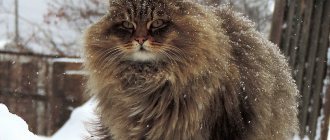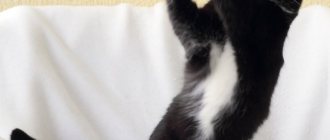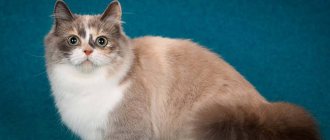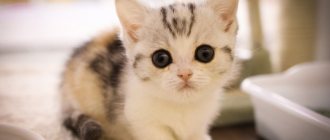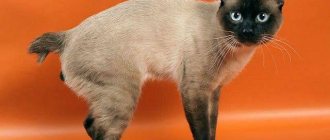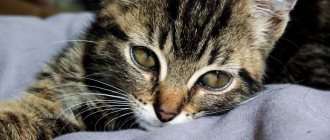Somali cats are beautiful animals with a unique ticked coloration and a luxurious fox-like tail. Their sophisticated appearance and piercing gaze of expressive eyes, combined with a playful disposition, make them desirable pets for novice felinologists. And in order not to make a mistake in choosing a breed, it is better to figure out in advance what else is hidden behind the mask of an exquisite aristocrat.
Brief history of the breed
The homeland of Somali cats is the United States, and they owe their appearance to American breeders. In the 40s of the last century, some breeders involved in breeding Abyssinians began to have kittens with long hair. Since they did not meet the generally accepted standard, they were considered a “manufacturing defect” and were distributed free of charge to friends.
This could have continued indefinitely if, in the late 1960s, long-haired Abyssinians had not attracted the interest of the owner of an American kennel, Evelyn Matthew. The woman named the unusual cats Somali and became the founder of the first society of lovers of this breed.
In parallel with her, the Canadian breeder Mary Mayling was promoting non-standard Abyssinians. She demonstrated long-haired beauties at exhibitions, helping to popularize them.
As a result, through joint efforts, the breeders were able to resist the resistance of Abyssinian nurseries that were actively fighting with competitors. Their actions led to Somalia being officially registered in the United States in 1978. And in 1982, the breed received recognition from the International Cat Federation.
Flaws in appearance
Often kittens do not meet all of these standards. If the breeder's goal is a companion cat for the home and family, these deviations are not a hindrance.
If the owner plans to take first places at exhibitions, the animal should be seriously studied.
Cats that have:
- There is no ticking.
- There are no “glasses” around the eyes.
- Irregular shape of the head and muzzle.
- Inelegant, rough body.
- Short tail.
- Gray undercoat.
- White markings on body.
- Cryptorchima (testicles not descended).
- Polydactyly (extra fingers).
At first glance, a cat may meet all the required characteristics, but with age, deviations can unexpectedly appear. These traits rarely affect the health of the cat, but its reproduction and participation in competitions are doomed.
Interesting Facts
Over the years of the breed’s existence, many interesting things have been associated with it:
- For its fluffy tail and fiery fur, the Somali cat received the nickname “domestic fox.”
- Representatives of the breed love to play with water. Somalia likes to catch splashes with its paws. In addition, they can independently open the taps and look at the dripping water for a long time.
- The name of the breed was not chosen by chance. Due to the fact that the ancestors of these animals were Abyssinian cats, it was decided to name them Somali in honor of the country that neighbors Abyssinia on the map (now Ethiopia).
Breed description, standards, appearance
Somali cats are fluffy animals with a stretched, flexible body and a long tail. Outwardly, they are very similar to representatives of the Abyssinian breed, but they have their own standard and several fundamental differences.
Dimensions and weight
Representatives of the Somali cat breed are not heavyweights. But due to the fact that they have developed sexual dimorphism, females look lighter and smaller than males. The average weight of a Somali cat is 2.5-4 kg. The weight of an adult cat can reach 4-5 kg.
Anatomical characteristics
A typical Somali cat should fit the following description:
- The head is wedge-shaped, with rounded lines, a smoothly contoured profile and a strong chin.
- The eyes are large, wide-set, almond-shaped. The iris color can vary from amber to green. Silver Somalis prefer green eyes.
- The ears are large, set far apart, with a wide base and slightly rounded tips.
- The body is flexible, long, with developed muscles, a slender neck and a slightly protruding chest.
- The limbs are slender, tall, with small oval paws.
- The tail is long, thick at the base, gradually tapering to the tip. Fluffy fur grows thickly on it.
Color and coat type
Somali cats are covered with a smooth, thick coat, under which lies a thin but dense down. There is less hair on the back and shoulder blades of this breed than on the belly. The Somali has a luxurious “collar” on its neck, and “pants” on its hind legs.
On a note. According to the standard, the Somali cat can have whiskers. And in the interdigital space the presence of tufts of wool is allowed.
The main distinguishing feature of the Somali cat is the presence of ticking. Each hair of an animal must have dark transverse stripes, and the more of them, the more valuable the individual is considered. According to the standard, Somali cats can have the following colors:
- Wild – brown-red or slightly reddish coat with black ticking. On the back of the Somali there is a dark line called the "dorsal strap".
- Sorrel is a coppery-red coat with red-brown ticking. The bases of the Somali hairs are apricot-colored. The tips of the ears and tail are brown, the paw pads and nose are pink.
- Fawn - matte beige coat with dark cream ticking. The bases of the hairs are colored light cream.
- Blue – gray-blue wool with steel ticking. The bases of the Somali cat's hairs are cream or light beige. Paw pads are gray with a blue tint.
On a note. Somali cats are allowed to have “silvered” colors. They are a combination of light base and ticking.
Possible breed defects
Flaws in appearance, in the presence of which a cat of the Somali breed will not receive the highest expert rating:
- short tail;
- rough build;
- heavy head;
- no ticking;
- cryptorchidism;
- gray undercoat;
- polydactyly;
- blurry shade of fur.
Character and temperament
Somali cats are endowed with a friendly and playful disposition. Aristocratic and sociable representatives of the breed remain cheerful until old age and extremely rarely show aggression. Curious and active, Somali cats are not the type to snooze quietly on the couch. They explore every corner of the apartment more than once and find something to do with themselves.
Friendly and sociable, Somalis get along well with children and will never let their claws out. The good nature of cats of this breed extends not only to people, but also to other animals. The non-conflict nature of the Somalia helps them easily find a common language with their brothers, non-aggressive dogs, fish, birds and ornamental rodents.
How to choose the right kitten
Somali cats are distributed throughout the globe. Therefore, there are usually no problems with buying such a pet. To protect yourself from possible deception, it is better to purchase a Somali kitten from a certified nursery or from a trusted breeder. At the time of purchase, he must have documents about his origin and vaccinations.
The Somali kitten chosen must meet the breed standard and show no signs of cowardice. It is important that he has clean eyes and ears, a soft belly, fluffy fur and smooth skin without scratching or rashes. A healthy Somali kitten should not have bad breath or dirt under its tail.
Kitten care
Responsible breeders do not wean Somali kittens from their mother before they are 12 weeks old. Therefore, kids move to new homes completely independent. This means that the owners can only give them a little time to get used to the changed conditions and ensure safety.
To prevent the curious Somali kitten from being injured while exploring his property, decorative plants, chemicals, small objects and wires are hidden from him. Also, for security reasons, his access to large household appliances and open windows is blocked.
Selecting a Somali kitten
A Somali kitten should be taken from a good nursery - in this case, the owner receives a healthy pet that meets breed standards. Owners of such nurseries are required to attend exhibitions where their animals can be seen in real life.
Somalis understand and feel their owners well - so raising them is not difficult
The cost of a Somali kitten on the Russian market is quite high: for a pet without breeding rights they ask for 25,000-50,000 rubles, a baby with a view to a further breeding career costs from 60,000 to 200,000 rubles. You should not try to save money by finding an advertisement for the sale of a kitten in a newspaper or on the Internet from persons unknown in the felinological world. They often sell a kitten at a price that is an order of magnitude lower than the market price, but as a result you are likely to get a sick or simply outbred animal.
Somalia will become a devoted friend and an excellent companion for people who are inclined to communicate and spend a lot of time at home. Having children is not an obstacle to acquiring Somali if the child is able to learn that a living creature is not a toy. In this case, everyone wins - the cat and human baby, as well as the parents of the latter.
Care and maintenance
Somali cats easily adapt to different conditions and do not require special care. The owner can only provide basic hygiene, proper feeding and timely veterinary care.
Hygiene procedures
In order for a cat of the Somali breed to look neat, it is provided with proper care:
- The animal's ears are cleaned weekly with a cotton swab soaked in a special lotion. If pus or other unusual discharge is detected, the cat is taken to the veterinarian.
- Somali eyes are wiped daily with a clean cloth moistened with boiled water or chamomile infusion.
- The cat's claws are shortened with a nail clipper as they grow. In order not to cause pain to your pet, you must act very carefully so as not to touch living tissue.
- Somali teeth are brushed 3-4 times a month with a special brush with a small amount of non-foaming paste. This procedure will help remove plaque and prevent stone formation.
Grooming
The Somali cat's coat is not prone to tangles. To ensure that the coat always looks well-groomed, it is regularly combed with a special comb with rare teeth.
Important! It is not recommended to brush Somali cats with plastic combs and brushes with artificial bristles, as they have a detrimental effect on the condition of the protective layer of the coat.
Representatives of the breed are bathed no more than 3-4 times a year. To do this, use yolk shampoos or products for long-haired breeds and water, the temperature of which does not exceed 40 degrees. A washed Somali cat is dried with a towel and dried with a hairdryer.
Tray
For cat litter, it is advisable to use a convenient, easy-to-clean tray with high sides. The litter is usually selected taking into account the preferences of a particular animal.
Feeding the cat
Somalis require a balanced diet and most breeders recommend dry feeding them. But cats will not refuse natural food. Therefore, when choosing food, each owner takes into account his own capabilities.
Complete diet
With the industrial type of nutrition, Somalis buy high-quality premium or super-premium food, which does not contain soy, preservatives or dyes. Cats of this breed digest well the following brands:
- Brit Care;
- Pronature;
- Royal Canin;
- Grandorf.
With a natural type of nutrition, Somalis select a diet that consists of 70-80% meat. The cat menu is also supplemented with cereals, non-starchy vegetables, offal, fermented milk, eggs and ocean fish.
It is strictly forbidden to treat Somalis with bones, sweets, pastries, sausages and pork. It is also undesirable to give cats of this breed river fish, onions, whole milk, smoked meats, pickles and any leftovers from the master's table.
Important! In order not to provoke gastrointestinal problems in your cat, it is not advisable to mix natural and industrial food.
Feeding frequency
Somali kittens eat little, but often. Therefore, when drawing up a feeding schedule, the age of the animal must be taken into account:
- up to 3 months – 5-6 times a day;
- 3-5 months – 4 times a day;
- 5-12 months – 3 times a day.
From the age of one year, the Somali cat is fed twice a day.
Vitamins and minerals
In the body of Somali cats that eat natural foods, a deficiency of microelements may occur. To compensate for the lack of nutrients, animals are given vitamin and mineral supplements twice a year. The choice of feeding should be made by a veterinarian, taking into account the characteristics of a particular cat.
On a note. If a Somali eats high-quality dry food, she does not need additional vitamins.
Nutrition
The cat tolerates high-quality ready-made food or food prepared at home equally well.
It is important not to alternate them with each other and to feed only something specific. The diet must include meat, eggs, dairy products, and butter.
Education and physical activity
Somalis are smart animals with good memory and a high level of intelligence. Representatives of the breed quickly become accustomed to the tray and easily learn the rules of behavior in the house. If desired, Somali cats can be taught basic commands.
Representatives of the breed are endowed with an energetic temperament and remain active even in old age. Therefore, owners need to make sure that the Somali has enough toys and a tall scratching post tree.
On a note. The Somali cat loves to be outside, especially if it is taught to walk on a harness from childhood.
Health
Characteristic diseases
The health of representatives of this breed is excellent; teeth and gums occasionally bother them. Therefore, regular preventive measures are mandatory.
Somali cats are friendly to animals of other species, sometimes even trying to make friends with them. At the same time, dogs, parrots, rabbits and unfamiliar cats are shocked by this attitude and do not always accept the offer to play
Vaccinations
At 9-12 weeks you can give your kitten the first vaccination. It will protect him from several diseases at once:
- chlamydia
- plague
- calicivirus
- rhinotracheitis
You can read more about distemper in cats here:
Vaccination requires revaccination (repeat) after about a month. The rabies vaccine, at the owner's request, is administered with the first or second vaccination.
Further revaccination - at 1 year, and then annually.
A cat needs to be taught to be neat from childhood, then there will be no problems in adulthood
Vaccinations and antiparasitic treatment
To prevent infectious and viral diseases, Somalis undergo routine vaccination. At the age of 7-8 weeks, a kitten of this breed is vaccinated against panleukopenia, rhinotracheitis and calcivirosis. After 28 days, he is vaccinated against the same diseases and against rabies. Subsequently, Somalis are vaccinated annually.
To prevent a cat of this breed from becoming infected with diseases carried by fleas and worms, it is regularly treated for external and internal parasites. Somali anthelmintic drugs are given once every six months with mandatory repetition after 10-14 days. The dosage of the medicine is calculated taking into account the weight of the cat.
Somalis are protected from fleas with drops, shampoos and anti-parasitic collars.
Diseases
Somali cats have strong immunity and low susceptibility to infections; they have few specific diseases.
- Firstly, Somalis are susceptible to such troubles as gingivitis (inflammation of the gums). Therefore, the owner needs to take special care of the cat’s teeth: brush them and show the pet to the veterinarian from time to time.
- Secondly, it recently became clear that autoimmune hemolytic anemia, which was considered a canine disease, is also susceptible to Somali cats. The diagnosis is made after donating blood according to the PCV classification, and treatment consists of prescribing steroid drugs.
The rest is the same as with other cats. Be sure to rid your cat of worms (even if she is sitting at home, and the environment around her is, in your opinion, sterile), get the necessary vaccinations, and work with your doctor to select a good vitamin and mineral complex. Then your pet will live long and feel good.
Pros and cons of the breed
Like any other breed of cat, the Somali has not only advantages, but also disadvantages.
| pros | Minuses |
| High level of intelligence | Need for space for games |
| Lack of excessive shedding | Tendency to serious illnesses |
| Low maintenance |
Somali cats are attractive animals with aristocratic habits and natural grace. Their mischievous nature and love for children make them real contenders for the right to be called ideal companions for young families in which kids who dream of a furry pet are growing up.
Vices
Good health does not insure an animal against hereditary diseases. Somalia is distinguished by the presence of several genetic diseases.
Progressive retinal atrophy
This pathology manifests itself in an animal at the age of six months and within a few years leads to complete loss of vision. The disease cannot be treated.
The only possible prevention is a thorough study of the pedigree when choosing a cat or preparing for mating. Detection is possible using electroretinography.
Hemolytic anemia
The cause of the disease is a lack of oxygen in the blood due to the destruction of red blood cells, which occurs due to a lack of a certain type of enzyme in the body. The cat will constantly be sick, pregnancy in this case becomes impossible. This makes itself felt throughout the pet’s life and requires constant treatment.
Due to the bottleneck effect, when few individuals remained after the war, all modern Abyssinian and Somali cats are close relatives, which makes them especially vulnerable to genetic pathologies.
Timely study of the pedigree will help the breeder choose an animal with minimal risk.
